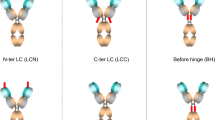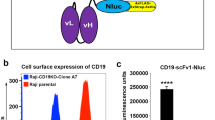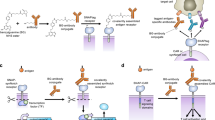Abstract
Artificial recombinant receptors may be useful for selectively targeting imaging and therapeutic agents to sites of gene expression. To evaluate this approach, we developed transgenes to express highly on cells a single-chain antibody (scFv) against the hapten 4-ethoxymethylene-2-phenyl-2-oxazoline-5-one (phOx). A phOx enzyme conjugate was created by covalently attaching phOx molecules to polyethylene glycol (PEG)-modified β-glucuronidase. Cells expressing phOx scFv but not control scFv receptors were selectively killed after exposure to ß-glucuronidase derivatized with phOx and PEG (phOx-βG-PEG) and a glucuronide prodrug (p-hydroxy aniline mustard β-D-glucuronide, HAMG) of p-hydroxyaniline mustard. Targeted activation of HAMG produced bystander killing of receptor-negative cells in mixed populations containing as few as 10% phOx-receptor-positive cells. Functional phOx scFv receptors were stably expressed on B16-F1 melanoma tumors in vivo. Treatment of mice bearing established phOx-receptor-positive tumors with phOx-βG-PEG and HAMG significantly (P⩽.0005) suppressed tumor growth as compared with treatment with βG-PEG and HAMG or prodrug alone. phOx was unstable in the serum, suggesting alternative haptens may be more suitable for in vivo applications. Our results show that therapeutic agents can be targeted to artificial hapten receptors in vitro and in vivo. The expression of artificial receptors on target cells may allow preferential delivery of therapeutic or imaging molecules to sites of transgene expression.
This is a preview of subscription content, access via your institution
Access options
Subscribe to this journal
Receive 12 print issues and online access
$259.00 per year
only $21.58 per issue
Buy this article
- Purchase on Springer Link
- Instant access to full article PDF
Prices may be subject to local taxes which are calculated during checkout







Similar content being viewed by others
Abbreviations
- HAMG:
-
p-hydroxy aniline mustard β-D-glucuronide
- pHAM:
-
p-hydroxyaniline mustard
- phOx:
-
4-ethoxymethylene-2-phenyl-2-oxazoline-5-one
- phOx-ßG-PEG:
-
ß-glucuronidase derivatized with phOx and polyethylene glycol
- scFv:
-
single-chain antibody
- TM:
-
transmembrane domain
- γ1:
-
H-CH2-CH3 region of human IgG1
References
Hank JA, Albertini MR, Sondel PM . Monoclonal antibodies, cytokines and fusion proteins in the treatment of malignant disease. Cancer Chemother Biol Response Modif. 1999;18:210–222.
Trail PA, Bianchi AB . Monoclonal antibody drug conjugates in the treatment of cancer. Curr Opin Immunol. 1999;11:584–588.
Buchsbaum DJ . Experimental radioimmunotherapy. Semin Radiat Oncol. 2000;10:156–167.
Hayden MS, Grosmaire LS, Norris NA, et al. Costimulation by CD28 sFv expressed on the tumor cell surface or as a soluble bispecific molecule targeted to the L6 carcinoma antigen. Tissue Antigens. 1996;48:242–254.
Rode HJ, Moebius U, Little M . T cell activation by monoclonal antibodies bound to tumor cells by a cell surface displayed single-chain antibody. J Immunol Methods. 1999;224:151–160.
Liao KW, Lo YC, Roffler SR . Activation of lymphocytes by anti-CD3 single-chain antibody dimers expressed on the plasma membrane of tumor cells. Gene Therapy. 2000;7:339–347.
Ye Z, Hellstrom I, Hayden-Ledbetter M, et al. Gene therapy for cancer using single-chain Fv fragments specific for 4-1BB. Nat Med. 2002;8:343–348.
Liao KW, Chen BM, Liu TB, et al. Stable expression of chimeric anti-CD3 receptors on mammalian cells for stimulation of antitumor immunity. Cancer Gene Ther. 2003;10:779–790.
Griffiths GM, Berek C, Kaartinen M, et al. Somatic mutation and the maturation of immune response to 2-phenyl oxazolone. Nature. 1984;312:271–275.
Hoogenboom HR, Griffiths AD, Johnson KS, et al. Multi-subunit proteins on the surface of filamentous phage: methodologies for displaying antibody (Fab) heavy and light chains. Nucleic Acids Res. 1991;19:4133–4137.
Farinas J, Verkman AS . Receptor-mediated targeting of fluorescent probes in living cells. J Biol Chem. 1999;274:7603–7606.
Chesnut JD, Baytan AR, Russell M, et al. Selective isolation of transiently transfected cells from a mammalian cell population with vectors expressing a membrane anchored single-chain antibody. J Immunol Methods. 1996;193:17–27.
Rode HJ, Little M, Fuchs P, et al. Cell surface display of a single-chain antibody for attaching polypeptides. Biotechniques. 1996;21:650–658.
Liao KW, Chou WC, Lo YC, et al. Design of transgenes for efficient expression of active chimeric proteins on mammalian cells. Biotechnol Bioeng. 2001;73:313–323.
Roffler SR, Wang SM, Chern JW, et al. Anti-neoplastic glucuronide prodrug treatment of human tumor cells targeted with a monoclonal antibody–enzyme conjugate. Biochem Pharmacol. 1991;42:2062–2065.
Cheng TL, Chen BM, Chan LY, et al. Poly(ethylene glycol) modification of beta-glucuronidase–antibody conjugates for solid-tumor therapy by targeted activation of glucuronide prodrugs. Cancer Immunol Immunother. 1997;44:305–315.
Morrison SL, Porter SB, Trinh KR, et al. Variable region domain exchange influences the functional properties of IgG. J Immunol. 1998;160:2802–2808.
Cheng TL, Wu PY, Wu MF, et al. Accelerated clearance of polyethylene glycol-modified proteins by anti-polyethylene glycol IgM. Bioconjug Chem. 1999;10:520–528.
Stocks SJ, Jones AJ, Ramey CW, et al. A fluorometric assay of the degree of modification of protein primary amines with polyethylene glycol. Anal Biochem. 1986;154:232–234.
Stribbling SM, Friedlos F, Martin J, et al. Regressions of established breast carcinoma xenografts by carboxypeptidase G2 suicide gene therapy and the prodrug CMDA are due to a bystander effect. Hum Gene Ther. 2000;11:285–292 (FTXT: Full text from Swets).
Cheng TL, Chou WC, Chen BM, et al. Characterization of an antineoplastic glucuronide prodrug. Biochem Pharmacol. 1999;58:325–328.
Baese HJ, Havsteen BH . 4-alkylidene oxazolones as substrates and inhibitors for sensitive assays of the normality of active sites and the catalytic properties of hydrolases. Biochim Biophys Acta. 1989;990:113–121.
Turner NA, Gaskin DJ, Yagnik AT, et al. Enantioselectivity of recombinant Rhizomucor miehei lipase in the ring opening of oxazolin-5(4H)-ones. Protein Eng. 2001;14:269–278.
Cheng TL, Chen BM, Chern JW, et al. Efficient clearance of poly(ethylene glycol)-modified immunoenzyme with anti-PEG monoclonal antibody for prodrug cancer therapy. Bioconjug Chem. 2000;11:258–266.
Freeman SM, Abboud CN, Whartenby KA, et al. The “bystander effect”: tumor regression when a fraction of the tumor mass is genetically modified. Cancer Res. 1993;53:5274–5283.
Hirschowitz EA, Ohwada A, Pascal WR, et al. In vivo adenovirus-mediated gene transfer of the Escherichia coli cytosine deaminase gene to human colon carcinoma-derived tumors induces chemosensitivity to 5-fluorocytosine. Hum Gene Ther. 1995;6:1055–1063.
Fick J, Barker II FG, Dazin P, et al. The extent of heterocellular communication mediated by gap junctions is predictive of bystander tumor cytotoxicity in vitro. Proc Natl Acad Sci USA. 1995;92:11071–11075.
Cheng TL, Wei SL, Chen BM, et al. Bystander killing of tumour cells by antibody-targeted enzymatic activation of a glucuronide prodrug. Br J Cancer. 1999;79:1378–1385.
Spooner RA, Martin J, Friedlos F, et al. In suicide gene therapy, the site of subcellular localization of the activating enzyme is more important than the rate at which it activates prodrug. Cancer Gene Ther. 2000;7:1348–1356.
Chen BM, Chan LY, Wang SM, et al. Cure of malignant ascites and generation of protective immunity by monoclonal antibody-targeted activation of a glucuronide prodrug in rats. Int J Cancer. 1997;73:392–402.
Chen BM, Cheng TL, Tzou SC, et al. Potentiation of antitumor immunity by antibody-directed enzyme prodrug therapy. Int J Cancer. 2001;94:850–858.
Leu YL, Roffler SR, Chern JW . Design and synthesis of water-soluble glucuronide derivatives of camptothecin for cancer prodrug monotherapy and antibody-directed enzyme prodrug therapy (ADEPT). J Med Chem. 1999;42:3623–3628.
Roffler SR, Chan J, Yeh MY . Potentiation of radioimmunotherapy by inhibition of topoisomerase I. Cancer Res. 1994;54:1276–1285.
Nettelbeck DM, Jerome V, Muller R . Gene therapy: designer promoters for tumour targeting. Trends Genet. 2000;16:174–181.
Russell SJ, Cosset FL . Modifying the host range properties of retroviral vectors. J Genet Med. 1999;1:300–311.
Wickham TJ . Targeting adenovirus. Gene Therapy. 2000;7:110–114.
Acknowledgements
We wish to thank Ms Ya-Min Lin of the Institute of Molecular Biology, Academia Sinica for assistance in cell sorting. This study was supported by grants from the National Science Council (NSC91-3112-P-001-026-Y) and Academia Sinica (AS-91-IBMS-3PP), Taipei, Taiwan.
Author information
Authors and Affiliations
Corresponding author
Rights and permissions
About this article
Cite this article
Cheng, TL., Liao, KW., Tzou, SC. et al. Hapten-directed targeting to single-chain antibody receptors. Cancer Gene Ther 11, 380–388 (2004). https://doi.org/10.1038/sj.cgt.7700712
Received:
Published:
Issue Date:
DOI: https://doi.org/10.1038/sj.cgt.7700712
Keywords
This article is cited by
-
Hapten-derivatized nanoparticle targeting and imaging of gene expression by multimodality imaging systems
Cancer Gene Therapy (2009)
-
Gene expression imaging by enzymatic catalysis of a fluorescent probe via membrane-anchored β-glucuronidase
Gene Therapy (2007)
-
A membrane antibody receptor for noninvasive imaging of gene expression
Gene Therapy (2006)



